Dormant Plants
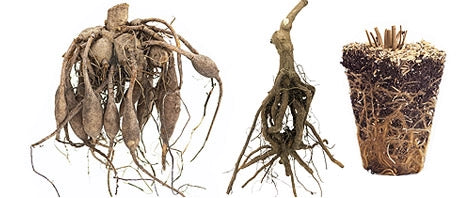
Why dormant plants are better plant starters
Grow healthier, more resilient plants using bulbs and bareroots
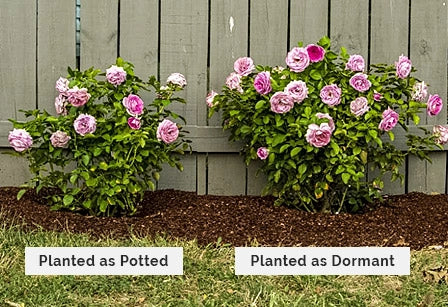
In the above photo, a rose started in a pot, left, and a rose started as a dormant bareroot, seen one year after each was planted. Dormant plants are hardier and establish more quickly.
Dormant plants give gardeners an edge, naturally
- Ease of planting
- Increased survivability
- Better overall growth
A dormant plant greatly reduces its metabolic activity in order to survive winter's bitterly cold temperatures and snowfall, so that come spring, the plant will re-emerge to thrive again. There may not appear to be much going on during this period of hibernation, but the opposite is true. During autumn, while the above-ground portions of these plants are releasing blooms and leaves, they are storing energy underground as
large caches of carbohydrates. This energy will be released and used to spark growth when the weather improves enough for the plants to sprout.
Shop Best Sellers
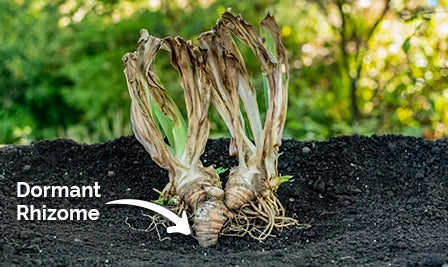
Bulbs and bareroots provide gardeners with several important advantages over plants that start in containers. When you receive a plant shipped in its dormant state, you know you will have an opportunity to enjoy its very first blooms and to watch its foliage emerge. It will also perform better and mature more quickly. On the other hand, an actively growing potted plant requires much more attention to timing and conditions. It can't be put outside, for instance, when it's too cold, too hot or too sunny for its overall health, otherwise it will suffer greatly and could even die.
Not only is a dormant plant best for planting, it's best for shipping, too. We learned many years ago there's no more reliable way to provide our customers with healthy, ready-to-grow products.
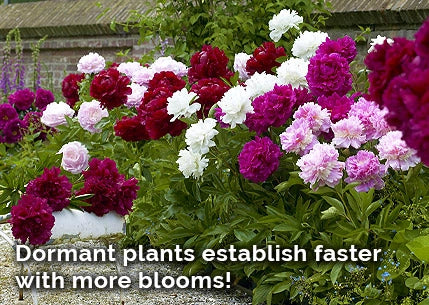
Planting them during dormancy will help ornamentals like peonies and tulips to be healthier and look more vibrant.
A better way to garden
Put frankly, dormant plants are a smarter choice for gardeners. Here are some facts about them:
- The roots of dormant plants adapt more quickly to native soil conditions than the roots of transplanted potted plants.
- Dormant plants are not as likely to become dehydrated. Nature encourages their roots to seek water and nutrients in their native soil—even though it often provides less favourable growing conditions than potting soil.
- There is no hardening-off process, no risk of sunburn. Bulbs and bareroot perennials are ready to go.
- Dormant plants have higher survival rates than potted plants.
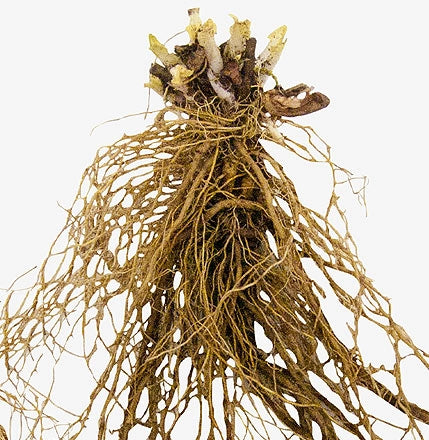
The buds on this peony are ready to explode with growth. Notice they are not yet breaking growth—a key to proper dormant storage.
Is there an advantage over store-bought potted plants?
Yes! There's no disputing the benefits of planting bulbs and dormant perennials over transplanting potted varieties:
- As we mentioned, a dormant plant provides you with a chance to witness its first blooms. A potted plant bought at your local store, by contrast, is already halfway through its bloom cycle and is more stressed than it would be growing in the ground.
- Dormant plants are far less costly than their potted counterparts.
- Dormant plants possess more potential energy for more vigorous growth. Their buds, stems and roots are chock-full of carbohydrate reserves, which fuel the plant's explosive growth when it goes into the ground. As for living potted plants, they have used up these reserves and have less energy for acclimating to their new environs.
- The root systems of dormant plants are stronger and more developed, their growth never having been limited by containers.
"Don't judge a book
by its cover!"
When it comes to gardening, good things come to those who wait. In short, all that's needed is a little faith in nature and to remember that our plants have been grown, cared for and stored properly to ensure your success.
It's important to be patient when starting with dormant plants, but your patience will be rewarded. Like many legendary heroes in literature, your amazing plants will also emerge from unpresuming beginnings.
Understand what to expect when your package arrives. Remember that discoloured or contorted dormant plants, such as bulbs, are not dead or in poor health. Plants are like people: They come in many shapes and sizes, but those physical constraints do not limit their potential.
Overlook the way they look
If you're used to buying live potted plants, receiving your first dormant plant can be a somewhat unsettling experience. Instead of getting a starter plant with leaves and possibly even some blooms, you will instead unpack what appears to be a clump of dried plant material. But don't panic. Many healthy dormant plants will look this way, such as these iris rhizomes.
Each of these is a healthy rhizome

Dormant plants, such as these iris rhizomes, will arrive in different stages of dormancy depending on the time of year they are shipped to you. Don't be concerned, for example, about dry foliage, such as that seen here. All these irises will perform equally well.
Make sure your dormant plant is healthy before setting it in the ground
It can be challenging to judge the condition of a dormant plant, particularly for those with little or no experience with them. Take these steps to help ensure yours has arrived ready to plant.
Perennials and Vines
-

A healthy perennial should have firm, well-hydrated roots that are neither wet nor slimy. It will perform well if the root system and crown are not dried out.
-

Many, but not all, perennials have "eyes". Look for brightly coloured ones (they can be white, green or other colours) that are firm and undamaged. The eyes should not be budding or elongating.
-

You may notice "storage mold" on your plant in splotches or light coatings. There's no need to worry as long as the roots are still firm. Storage mold will not affect growth.
-
Check out our comprehensive
PERENNIAL PLANTING GUIDES
for even more information and videos!
Shrubs
-

Shrubs are like all dormant, woody plants in that they should have strong, hydrated stems and branches. They should not be drying out or rotting.
-

As in the case of these roses, look for a well-hydrated plant with firm buds that are swollen but not yet ready to break.
-

To ensure its health, gently scratch away some of the shrub's bark at its base. You want to see hydrated flesh that's green or white.
-
Check out our comprehensive
SHRUBS PLANTING GUIDES
for even more information and videos!
Bulbs
-

Expect a healthy bulb to feel firm and to be an appropriate weight for its size. Don't plant any with rot or excessive mold.
-

While virtually all flowers are beautiful, not all bulbs are. But that doesn't mean they won't perform well, even if they're smaller or have some scarring like these tulips. Plant such bulbs confidently.
-

Watch for excessive mold, but light amounts of "storage mold" are harmless and will not affect performance.
-
Check out our comprehensive
BULBS PLANTING GUIDES
for even more information and videos!
Tubers
-
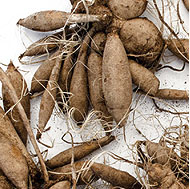
A healthy dahlia tuber will be firm and feel as if its weight is correct for its size. Examine it more closely if it feels hollow or looks too dried out.
-
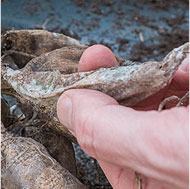
Some tubers, such as these dahlias, will not always appear healthy. But if they're well hydrated, issues like this "storage mold" will not affect their growth.
-

Tubers don't have to be large to perform well. Even small root systems like this one will do fine if cared for properly.
-
Check out our comprehensive
TUBERS PLANTING GUIDES
for even more information and videos!
MISCELLANEOUS
-

Dormant plants can take many unique forms, such as the one taken by this iris.
-

Don't worry if your dormant plant's foliage resembles this rhizome's. The plant will perform as it should as long as the fleshy portions of the root system are firm upon arrival.
-

You might notice some "pups", or offshoots, on dormant plants like this iris. That's OK. In fact, the more pups, the better, because they help promote new growth more quickly.
-
Check out our comprehensive
PLANTING GUIDES
for even more information and videos!












